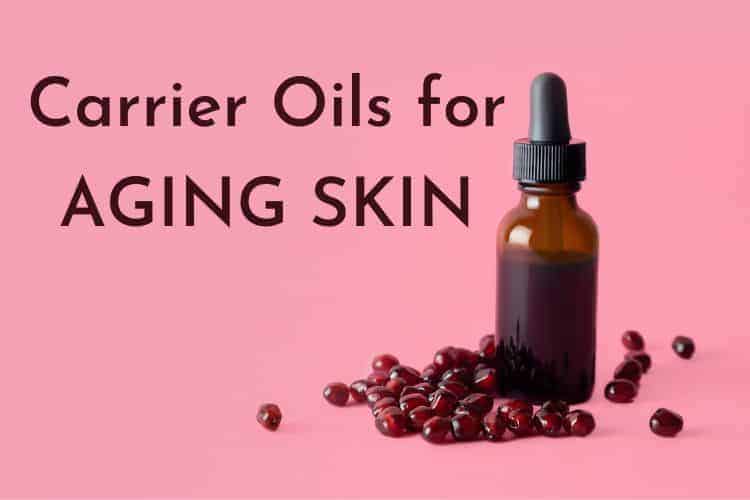
While all skin types are unique and deserve the very best care, mature skin generally calls for more tender loving care.
This is because the natural aging process involves a variety of chemical changes that contribute to:
- wrinkles.
- a decline in the production of collagen, sebum, ceramides and other compounds.
- dryness and a loss of moisture.
- dull skin.
- loss of plumpness and elasticity.
While we can’t stop aging, we can definitely nourish the skin and ultimately, enjoy more vibrant-looking skin.
So, in this article we’re going to focus on topical nourishment by looking at 11 carrier oils for aging skin.
As you go through this list, you will notice that all oils have some things in common – for example, they’re all occlusive and contain fatty acids.
However, each oil also has its own unique properties and when used correctly, it can make all the difference in how your skin looks and feels.
So, without further delay, let’s dive into these oils!
Note: this post contains some affiliate links and I earn a commission (at no additional cost to you) if you use them to make a purchase.
WHICH CARRIER OILS ARE BEST FOR MATURE SKIN?
1. Rosehip Oil
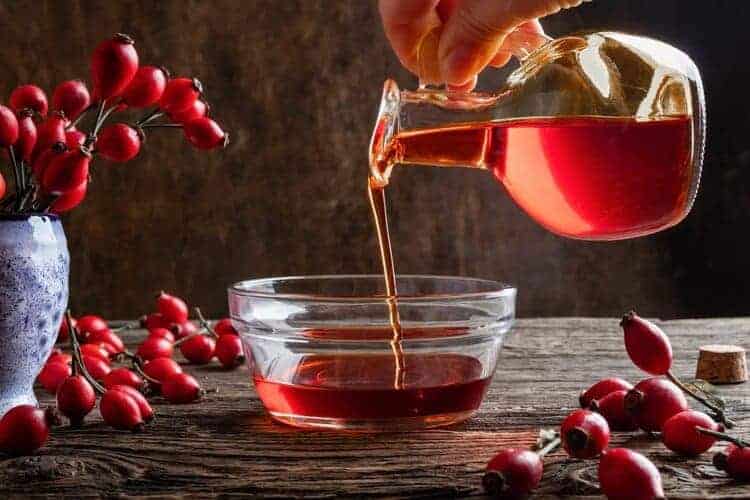
This oil’s deep orange-red color immediately highlights its powerful anti-aging potential, which is mostly due to its carotenoid content.
Among the carotenoids in rosehip oil, beta carotene is the most abundant.
Since beta carotene can be converted to preformed vitamin A (aka retinol), this means rosehip oil may help you get retinol-like results (in a gentler form).
Most importantly for aging skin, research shows retinol stimulates collagen production by increasing the number of fibroblast cells
These cells produce collagen, elastin, and hyaluronic acid – all of which will encourage a more youthful appearance (source).
Overall, rosehip oil may help to:
- Improve wrinkles.
- Reduce acne.
- Minimize hyperpigmentation.
- Soothe inflammatory conditions (such as rosacea or psoriasis).
For a deeper dive into its benefits and uses, read this guide on rosehip for skin.
2. Prickly Pear Oil
Although prickly pear oil is highly versatile and can benefit anyone, its nutrient content makes it particularly useful for mature skin (both to prevent and reverse the signs of aging.)
Overall, prickly pear oil contains (source):
- Fatty acids.
- Antioxidants (such as phenols and vitamin E)
- Phytosterols (these are lipid compounds that moisturize and calm the skin).
In particular, vitamin E acts as a protective shield against environmental pollutants and stressors that contribute to skin damage and premature aging.
In addition, vitamin E also acts as an emollient to soften and smoothen the skin, while improving plumpness and elasticity.
And if that’s not enough, prickly pear’s fatty acid composition – it’s a good source of linoleic acid—makes it an effective carrier oil for (source):
- Increasing nutrient penetration into the skin.
- Enhancing the skin’s ability to retain hydration.
3. Jojoba Oil
Dry skin is something that tends to happen as we get older.
One of the main reasons why this happens is because our sebaceous glands naturally produce less sebum over time.
Thankfully, jojoba oil has the unique ability to mimic our actual sebum, thus helping to counteract irritation and dryness.
This is largely attributed to the presence of eicosenoic acid, an omega-9 fatty acid, in jojoba oil. Sebum also happens to contain eicosenoic acid as one of its main constituents.
In addition, jojoba oil acts as an emollient and occlusive, which means it can help to:
- Soothe and soften.
- Protect and repair the skin barrier, whose function is often impaired with the passing of time (1, 2).
Last but not least, research also shows that the antioxidants in jojoba help collagen synthesis (source).
Curious about how to use jojoba? Here’s a guide on what to mix with jojoba oil for face.
4. Oat Oil
As a natural source of ceramides, oat oil can be a true godsend for mature skin.
This is because the production of ceramides – lipids that constitute up to 40% of the epidermis – slows down with age (source).
With less ceramides in the outer layer of the skin, you are more likely to experience dryness and itchiness.
In addition, ceramides are crucial for maintaining healthy, youthful skin since they:
- Improve skin barrier function.
- Retain moisture.
- Protect against environmental damage.
- Promote healthy skin cells.
- Help the skin remain supple and hydrated.
In addition, oat oil – just like oats themselves – is known to soothe irritated, delicate or inflamed skin (source).
5. Cold Pressed Carrot Seed Oil
Carrots are known for being rich in beta-carotene, and so is carrot seed oil.
As we’ve already discussed, beta carotene is invaluable when dealing with aging skin since it’s a precursor to vitamin A and can be converted to retinol.
In addition, beta carotene helps to (source):
- Neutralize environmental free radicals.
- Defend against UVA light damage.
- Reduce oxidative stress.
And like all carrier oils, cold pressed carrot seed oil nourishes the skin with vitamin E and essential fatty acids.
To get all the ins and outs of carrot oil, use this guide on carrot oil vs carrot seed oil.
6. Hazelnut Oil
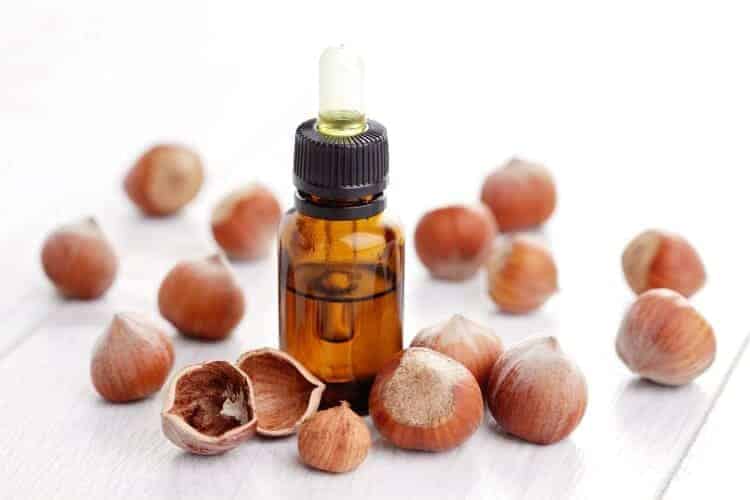
Hazelnut oil is considered a high source of vitamin E. This can have lots of positive effects on mature skin because vitamin E:
- helps to combat the collagen-destroying enzyme, collagenase, which increases with age (source).
- provides future protection from sun damage by combating free radicals and shielding cell membranes (source).
- may help with fine lines and hyperpigmentation (source).
7. Pomegranate Seed Oil
If you’re dealing with age-related dryness or want to help prevent it – and the subsequent signs of aging that can result – pomegranate seed oil is ideal because it contains punicic acid.
This omega-5 fatty acid has a variety of anti-aging properties. Most notably, punicic acid has been shown to increase both collagen and elastin, which are crucial elements for healthy skin (source).
Additionally, research shows that punicic acid:
- Acts as an antioxidant.
- Prevents moisture loss.
- Has anti-inflammatory effects.
Furthermore, punicic acid works with ellagic acid – a polyphenolic compound in pomegranates and other fruits – to (source):
- Prevent UV damage.
- Reduce hyperpigmentation.
- Inhibit metalloproteinase (an enzyme that breaks down collagen.)
8. Plum Oil
Plum oil, or more accurately plum kernel oil, is a nutrient-rich, lightweight oil that has been used in traditional Japanese, Korean and Chinese medicine for over 2000 years.
And once you understand the benefits, you’ll understand why it’s been used so extensively throughout history.
Specifically, this powerhouse oil provides:
- Antioxidants such as polyphenols and vitamins A & E.
- Essential fatty acids
Together, these constituents support healthy skin by (source):
- Protecting against environmental damage and inflammation, which can interfere with healthy collagen production.
- Helping the skin retain moisture.
- Increasing cell turnover and healing the skin of minor irritations and damage.
9. Sea Buckthorn Oil
When you use sea buckthorn oil you benefit from a rare omega-7 fatty acid: palmitoleic acid.
Oils high in omega-7 have renowned healing potential, with research showing it can even accelerate burn wound healing (source).
When you combine this with another of the oil’s compounds – gamma linolenic acid (GLA) – you begin to see why it’s so effective.
When it comes to the omega-6 fatty acid, GLA, it can be a great ally for aging skin because it:
- Improves skin elasticity.
- Minimizes dryness.
- Has antioxidant properties.
But that isn’t all! Sea buckthorn oil also features a wonderful combination of vitamin E, K and palmitic acid that can (source):
- Optimize the skin’s collagen and elastin levels.
- Nourish the skin with emollient properties.
And, because of its oleic and stearic acid content, this oil has occlusive properties that help seal moisture into the skin.
10. Macadamia Nut Oil
Want to get your hands on omega-7s without using sea buckthorn oil? Then macadamia nut oil is for you.
Macadamia oil happens to be one of the only other sources of omega-7 fatty acids.
However, macadamia’s omega-7 content is lower than sea buckthorn’s: 18% vs 32 – 42% respectively (3, 4)
Lastly, like many other oils macadamia oil is a natural occlusive and a natural source of protective vitamin E.
11. Chia Seed Oil
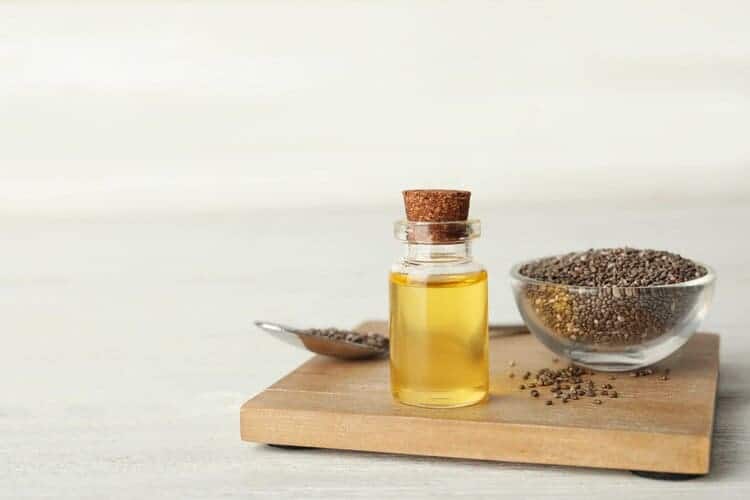
One of the main characteristics of chia seed oil is its high fatty acid content, specifically its high levels of alpha-linoleic acid (ALA.) This omega-3 has various benefits for mature skin, such as (source):
- Acting as an anti-inflammatory.
- Stimulating and building collagen.
- Minimizing UV-induced photo damage.
- Improving extrinsic signs of aging.
- Positively impacting the skin’s fatty acid composition.
Linoleic acid, an omega-6 fatty acid, further enhances chia seed oil, acting alongside ALA to (source):
- Repair damage to the skin barrier.
- Support essential lipids in the skin.
- Restore the skin’s moisture barrier to help lock-in hydration.
And if this isn’t enough, chia seed oil’s emollient properties, combined with its zinc and vitamin B3 content, act together to restore radiance to dull skin (source).
HOW TO USE OILS FOR AGING SKIN
Here are some tips for how to include these oils into your routine:
- Use it as the final step in your routine (before sunscreen).
- If you use moisturizer, apply oils after.
- To use oils as a substitute for moisturizer, make sure your face is damp before applying the oils. Oils lock in moisture so you don’t want to apply them to dry skin.
- Add a few drops of oil into your favorite clay mask to make it less drying.
- Make sure to apply the oils down your neckline. The skin in that area needs plenty of TLC too!
BEST FACE OILS FOR MATURE SKIN
1. Rosehip Oil from Kosmea
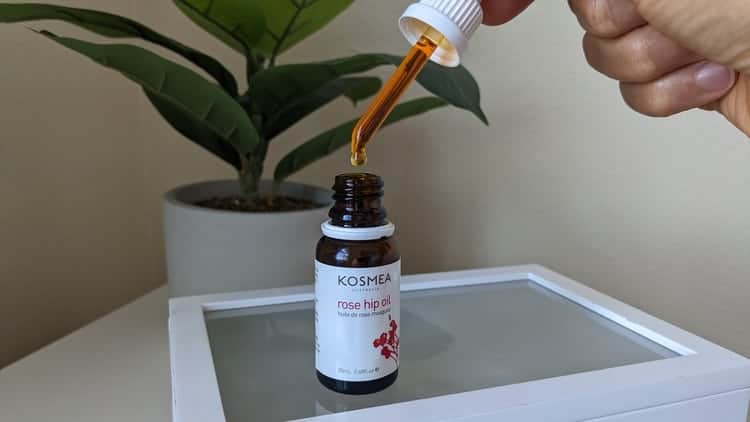
When I want a pure rosehip oil with nothing added, this is the only one I reach for. It is extracted from the whole rosehip i.e. seed and outer flesh (which has about 5 times more beta carotene than the seed, making this more potent than a rosehip seed oil).
Lastly, this oil is extracted with carbon dioxide, a process that uses low temperatures (helping to preserve as many of the delicate constituents as possible).
2. Carrier Oils for Mountain Rose Herbs
Mountain Rose Herbs is one of my personal go-to companies for raw ingredients. Not only do they have a wide selection of carrier oils, but they also have herbs (in case you’d like to make your own herb-infused face oil!)
Their sea buckthorn oil is particularly noteworthy because it is pressed from the whole berry with the seeds. Often times, brands sell these as separate oils.
Having both together gives you the full spectrum of sea buckthorn’s benefits in one convenient product.
3. Simply Face Oil

When I first received a free sample of this Simply Face Oil, one of the things that I liked about it was the silky, smooth feel. This is likely due to the inclusion of quick absorbing oils like rosehip, grapeseed and jojoba.
In addition, many of the oils used are rich in linoleic acid, which is oh-so essential for a healthy skin barrier as we get older.
Unlike some other products that load up on essential oils, this one keeps things simple with just two: frankincense and geranium. Both are anti-inflammatory and known for supporting skin renewal.
Not only does the oil feel smooth, but it has a lovely floral scent that makes for a very pleasant experience each time I use it!
4. Simply Neck Oil
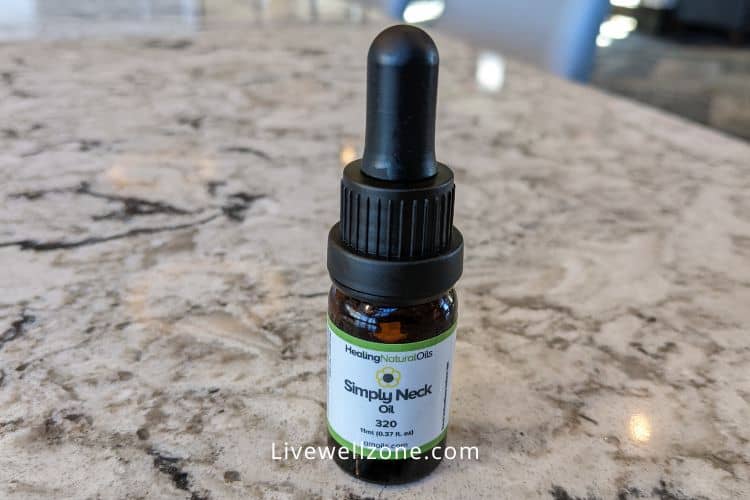
Besides the face oil, Healing Natural Oils also sent me a free sample of their neck oil. To be honest, I have never been one to use separate products on my face and neck.
But I know that for some people, the skin on the neck can have a mind of its own!
And there’s only so much you can do to cover up with a stylishly placed scarf (thank you Nora Ephron!).
So, if the skin on your neck and décolleté could use some extra pampering, then consider this Simply Neck Oil.
Taking a lead from the Simply Face Oil, the neck oil is also formulated with soothing oils like hazelnut, rosehip, jojoba and helichrysum.
However, this blend gets an added boost from antioxidant-rich pomegranate seed oil and ylang ylang essential oil (another powerhouse in the anti-aging department).
As far as the consistency goes, I find the neck oil to be quite lightweight (so you don’t have to worry about stains on clothing). And just like the Simply Face Oil, this oil also has a floral scent. In this case, it’s much more exotic and subtle (thanks to the ylang ylang).
FAQs ABOUT OILS FOR MATURE SKIN
Which oils promote collagen?
Oils that may help boost collagen production include avocado, rosehip, jojoba, pomegranate, sea buckthorn, hazelnut and chia seed oil.
CONCLUSION
Carrier oils have a diverse nutritional profile that makes them ideal for the diverse needs of aging skin.
As you become more familiar with the composition of each oil, you will be able to craft a blend that is tailored to your skin.
Or at least, you will have an easier time choosing an off-the-shelf blend that works for you!
You Might Also Like:
Carrier Oils By Skin Type: Benefits, How to Choose and List for Beginners
Non-Greasy Carrier Oils For Skin: 10 Oils To Fall In Love With

